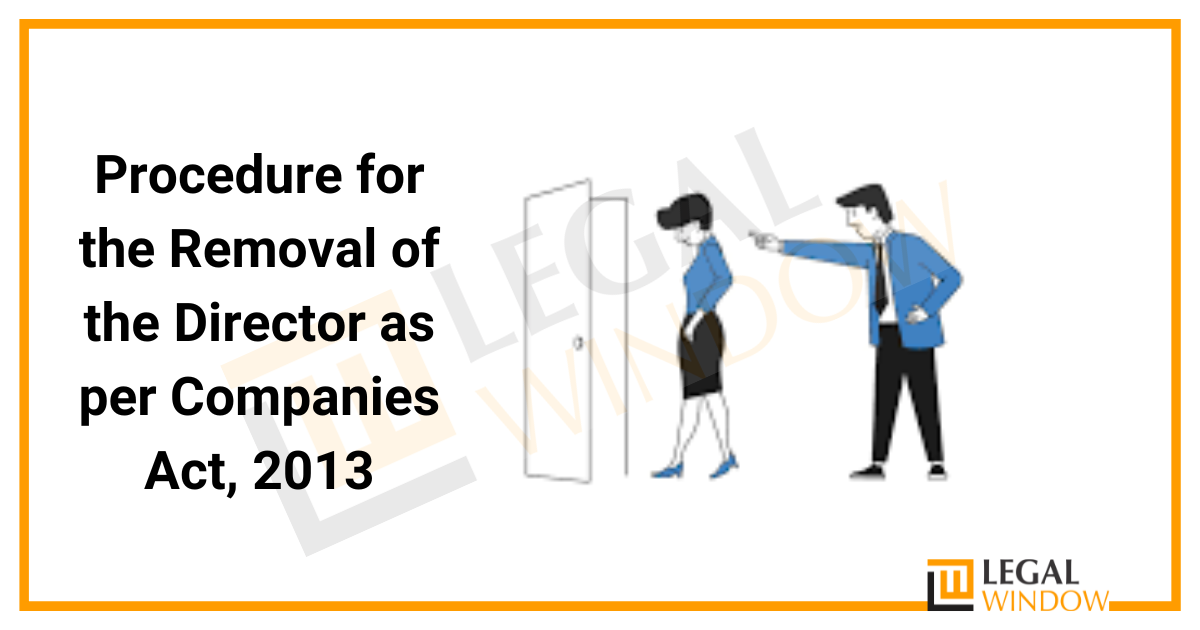Procedure for the Removal of the Director as per Companies Act, 2013
- May 15, 2023
- Change in Business

In India, the Companies Act, 2013 outlines the procedure for the removal of a director from a company. The director of a company is an integral part of its management and plays a crucial role in the functioning and decision-making process of the company. However, in certain cases, it may become necessary to remove a director due to various reasons. This article explains the procedure for the removal of a director under the Companies Act, 2013.
Quick Look
A person chosen by shareholders to oversee the company’s affairs after MOA and AOA is known as a company director. The company can only do it through a natural person agency since it is an artificial person. As a result, the board of directors must oversee the company’s operation and the director must be a live individual. Depending on the requirements of the company’s shareholders, the appointment of directors may be necessary occasionally. A company’s director is an essential member of the management team and plays a significant influence in how the company operates and makes decisions. But occasionally, for a variety of reasons, it could be essential to remove a director.
Who is a Director in Company?
A person nominated to the company board is referred to as a director under the Companies Act, 2013. The Board of Directors is a team of people chosen by the shareholders of the company to run its operations. A company is a legal entity that can only act with the help of human beings. The group of people tasked with overseeing a company’s directors is known as the board of directors.
A person who manages, controls, or directs anything is referred to as a director. A director also oversees, manages, or supervises. He or she is a person designated by law and permitted to manage and supervise the business of the company. He or she is chosen by the shareholders of a company to set the company’s policies.
Director’s Responsibility in a Company
The day-to-day management of a company is the responsibility of a director. They make important tactical and strategic decisions that aid the company in achieving its objectives. If the firm has shareholders, the director might be held accountable for them. The director must carefully balance the interests of shareholders with those of the company and its staff. The director of the company might have a strong sense of ethics and the ability to make decisions that adhere to legal requirements. Some of the most important duties of a company director are listed below:
- Create key performance indicators (KPIs) to help staff members concentrate their efforts.
- Plan community social responsibility initiatives with assistance from other corporate employees.
- Encourage adherence to the company’s code of ethics as well as its laws and regulations.
- Manage the day-to-day operations of the company.
- Make sure the company’s records are secure and kept up-to-date.
- Make sure that anything your business does complies with the laws at the time.
- A plan for controlling and enhancing corporate affairs and operations.
Removal of a Director from a Company as per Companies Act, 2013
The Companies Act, 2013 provides a detailed procedure for the removal of directors from their position. The Act aims to ensure that the removal process is transparent, fair and in compliance with legal requirements. The removal of a director can be initiated by the company, shareholders or the Central Government. The removal of a director can happen due to various reasons, including misconduct, non-performance, or breach of duties. The process for the removal of a director is crucial for maintaining transparency and ensuring that the company is run efficiently.
By delivering the greatest service, prompt delivery, and the highest level of customer satisfaction, Legal Window can assist you with the Removal of the Director from the Company with only a few simple actions. Contact our team at 072407-51000 or by email at admin@legalwindow.in.
Grounds for Removal of a Director
Before initiating the removal process of a director, the company must ensure that the grounds for removal are valid. According to the Companies Act, 2013, a director can be removed from office by passing a special resolution. The grounds for removal can be any of the following:
- If the director has been convicted of any offense by a court of law.
- If the director has become insolvent or has been declared bankrupt.
- If the director is of unsound mind and has been declared so by a competent court.
- If the director has not attended board meetings for a continuous period of 12 months without obtaining leave of absence from the board.
- If the director has been found guilty of any fraud or breach of trust.
- If the director has violated any provision of the Companies Act or any other law.
Procedure for Removal of a Director
The procedure for the removal of a director can be initiated by the board of directors or by the shareholders of the company. The steps involved in the process are as follows:
- Step 1: Board Meeting: The first step in the removal process is to convene a board meeting. A notice must be sent to all directors of the company, stating the reason for the meeting. The board meeting must be held within 7 days of the notice being sent. During the meeting, the board must pass a resolution proposing the removal of the director.
- Step 2: Special Notice: After the board meeting, a special notice must be sent to all shareholders of the company, stating the proposed resolution to remove the director. The notice must be sent at least 14 days before the general meeting.
- Step 3: General Meeting: A general meeting must be convened to discuss the proposed resolution to remove the director. The director must be given an opportunity to be heard at the meeting. The resolution must be passed by a majority of not less than three-fourths of the shareholders present and voting.
- Step 4: Filing of Form DIR-12: After the resolution has been passed, the company must file Form DIR-12 with the Registrar of Companies within 30 days of passing the resolution. The form must contain the details of the director who has been removed.
- Step 5: Intimation to the Director: The company must inform the director who has been removed of the resolution passed at the general meeting. The director must be given a copy of the resolution along with the reasons for the removal.
Important points of consideration regarding the Removal of the Director as per Companies Act, 2013
Removing a director from a company is a critical decision that requires careful consideration and adherence to legal procedures. The Companies Act, 2013, provides a framework for the removal of directors and lays down specific rules and regulations that need to be followed. It is essential to understand these rules and regulations to avoid any legal repercussions that may arise from the removal of a director.
- Grounds for Removal: The Companies Act, 2013, provides certain grounds for the removal of directors. These grounds include non-performance of duties, breach of trust, fraud, misappropriation of funds, and any act that is against the interests of the company. It is important to establish these grounds before initiating the removal process.
- Initiating the Removal Process: The removal of a director can be initiated by the shareholders, the board of directors, or the central government. The process of removal involves passing a resolution at a general meeting or a board meeting. The resolution must be passed by a majority of not less than two-thirds of the members present and voting at the meeting.
- Notice of the Meeting: A notice of the meeting must be given to all the members, directors, and auditors of the company. The notice must specify the intention to remove the director and must provide the reasons for the proposed removal. The notice must be given at least fourteen days before the meeting.
- Opportunity to be Heard: Before passing the resolution for the removal of a director, the director must be given an opportunity to be heard. The director must be informed of the allegations against him and given an opportunity to present his case. This is a fundamental principle of natural justice that must be adhered to.
- Intimation to the Registrar: Once the resolution for the removal of a director is passed, the company must intimate the Registrar of Companies (ROC) within thirty days of the resolution. The ROC will then update its records and remove the director’s name from the list of directors.
- Remuneration and Compensation: If a director is removed before the expiry of his term, he is entitled to receive compensation for the loss of office. The compensation cannot exceed the remuneration payable to the director for a period of three years. However, if the director is removed for reasons of misconduct, he is not entitled to any compensation.
Takeaway
Removing a director is a serious decision that must be taken after careful consideration of all the legal requirements. The Companies Act, 2013, provides a framework for the removal of directors, and it is essential to understand and adhere to these rules to avoid any legal repercussions. Companies must ensure that they follow the proper procedure for the removal of directors and provide an opportunity to be heard to the concerned director before passing the resolution. Companies must also ensure that they comply with the provisions related to compensation and intimation to the Registrar of Companies.
CS Urvashi Jain is an associate member of the Institute of Company Secretaries of India. Her expertise, inter-alia, is in regulatory approvals, licenses, registrations for any organization set up in India. She posse’s good exposure to compliance management system, legal due diligence, drafting and vetting of various legal agreements. She has good command in drafting manuals, blogs, guides, interpretations and providing opinions on the different core areas of companies act, intellectual properties and taxation.
Categories
- Agreement Drafting (23)
- Annual Compliance (11)
- Change in Business (36)
- Company Law (148)
- Compliance (90)
- Digital Banking (3)
- Drug License (3)
- FEMA (17)
- Finance Company (42)
- Foreign Taxation (6)
- FSSAI License/Registration (14)
- GST (119)
- Hallmark Registration (1)
- Income Tax (201)
- Latest News (34)
- Miscellaneous (164)
- NBFC Registration (8)
- NGO (14)
- SEBI Registration (6)
- Section 8 Company (7)
- Start and manage a business (21)
- Startup/ Registration (130)
- Trademark Registration/IPR (40)
Recent Posts
About us
LegalWindow.in is a professional technology driven platform of multidisciplined experts like CA/CS/Lawyers spanning with an aim to provide concrete solution to individuals, start-ups and other business organisation by maximising their growth at an affordable cost.









